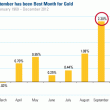U.S. Equity Market Radar (September 9, 2013)
The S&P 500 rebounded this week on better global economic data. A weak jobs report here in the States on Friday raises questions around the Federal Reserve’s willingness to “taper” which also gave the market a lift on continued quantitative easing. Cyclicals tended to outperform while interest rate sensitive areas were down for the week. The 10-year treasury yield touched 3 percent on Thursday before rallying on Friday on the weak jobs data.
Strengths
- The health care sector was the best performer as the sector experienced broad based gains. Medical product stocks were relative outperformers with good performance from Boston Scientific, St. Jude Medical, Medtronic and Stryker.
- The materials and energy sectors were both strong performers as global manufacturing indicators are seeing positive surprises. Oil prices remain strong on the back of better economic data but also unrest in the Middle East is having an impact.
- J.C. Penney was the best performer in the S&P 500 this week, rising 15.08 percent as the company continues to restructure and reported that it is ending its relationship with Martha Stewart Living.
Weaknesses
- The telecommunication services and utilities sectors were the worst-performing sectors as yields continue to climb, negatively affecting these interest rate sensitive groups.
- Housing-related areas were under pressure this week with homebuilders, home improvement retailers and furniture retailers all among the worst industry group performers for the week.
- Microsoft was the worst performer in the S&P 500 for the week, falling 7.12 percent. The company announced the acquisition of Nokia’s handset division, apparently completing the company’s foray into the mobile phone space.
Opportunity
- The current macro environment remains positive as economic data remains robust enough to give investors confidence in an economic recovery but not too strong as to force the Fed to change course in the near term.
- Money flows are likely to find their way into domestic U.S. equities and out of bonds and emerging markets.
- An improving macro backdrop out of Europe and China could be the next catalyst for the market to move higher.
Threat
- A market consolidation could occur in the near term after such a strong year.
- Higher interest rates are a threat for the whole economy. The Fed must walk a fine line and the potential for policy error is potentially large.
- Seasonally, September is one of the worst months of the year. Volatility coming into the Federal Open Market Committee (FOMC) meeting in mid-September should be expected.















